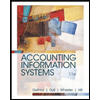INTERNAL CONTROLS FOR COLLECTION OF RECEIVABLES Carolyn Furniture Galleries sells traditional furniture from two stores in St. Louis. Carolyn’s credit terms allow customers to pay for purchases over three months with no finance charges. Carolyn’s accountant has been responsible for approving customers for credit, recording cash received from customers in the accounting records, depositing cash collections in the bank, and following up on customers who are behind in their payments. Each month the accountant has prepared a report for Carolyn’s president, indicating the cash collected, outstanding receivables, and uncollectible accounts. Carolyn’s president has been concerned about a significant increase in uncollectible accounts that began about two years ago, shortly after the current accountant was hired. Recently, a personal friend of Carolyn’s president called. The caller had moved from St. Louis to Denver about six months ago. A month ago, the caller’s new bank had refused a loan because a credit rating bureau in St. Louis had indicated that the caller had left bills unpaid at Carolyn Furniture. Carolyn’s president knew that the caller had paid his account before leaving the community. Carolyn’s president called a detective agency and arranged for an investigation. Two weeks later, Carolyn’s president was informed that the accountant had been spending much more money than his salary would warrant. Carolyn then called its auditor and arranged to have the accounting records for receivables and uncollectible accounts examined. This examination indicated that about $400,000 of cash had been stolen from the firm by the accountant. The accountant had identified customers who had moved and had recorded cash sales to continuing customers as credit sales in the accounts of the relocated customers. Carolyn’s accountant had kept the cash received from the cash sales and had eventually written off the fictitious credit sales as uncollectible accounts. Without the accountant’s knowledge, one of Carolyn’s new employees had sent the names of the customers who had apparently defaulted on their accounts to the credit bureau.
INTERNAL CONTROLS FOR COLLECTION OF RECEIVABLES
Carolyn Furniture Galleries sells traditional furniture from two stores in St. Louis. Carolyn’s credit terms allow customers to pay for purchases over three months with no finance charges. Carolyn’s accountant has been responsible for approving customers for credit, recording cash received from customers in the accounting records, depositing cash collections in the bank, and following up on customers who are behind in their payments. Each month the accountant has prepared a report for Carolyn’s president, indicating the cash collected, outstanding receivables, and uncollectible accounts. Carolyn’s president has been concerned about a significant increase in uncollectible accounts that began about two years ago, shortly after the current accountant was hired. Recently, a personal friend of Carolyn’s president called. The caller had moved from St. Louis to Denver about six months ago. A month ago, the caller’s new bank had refused a loan because a credit rating bureau in St. Louis had indicated that the caller had left bills unpaid at Carolyn Furniture. Carolyn’s president knew that the caller had paid his account before leaving the community. Carolyn’s president called a detective agency and arranged for an investigation. Two weeks later, Carolyn’s president was informed that the accountant had been spending much more money than his salary would warrant. Carolyn then called its auditor and arranged to have the accounting records for receivables and uncollectible accounts examined. This examination indicated that about $400,000 of cash had been stolen from the firm by the accountant. The accountant had identified customers who had moved and had recorded cash sales to continuing customers as credit sales in the accounts of the relocated customers. Carolyn’s accountant had kept the cash received from the cash sales and had eventually written off the fictitious credit sales as uncollectible accounts. Without the accountant’s knowledge, one of Carolyn’s new employees had sent the names of the customers who had apparently defaulted on their accounts to the credit bureau.
Step by step
Solved in 4 steps









